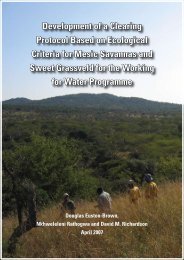Business Case forthe Pongola-Umzimkulu Catchment Management ...
Business Case forthe Pongola-Umzimkulu Catchment Management ...
Business Case forthe Pongola-Umzimkulu Catchment Management ...
You also want an ePaper? Increase the reach of your titles
YUMPU automatically turns print PDFs into web optimized ePapers that Google loves.
<strong>Business</strong> <strong>Case</strong> for the <strong>Pongola</strong>-<strong>Umzimkulu</strong> <strong>Catchment</strong> <strong>Management</strong> Agency<br />
• Conducting and commissioning water resources studies and investigations on<br />
water resources, advising DWA and interested parties on the matter and<br />
providing support to integrated water resources planning through:<br />
o Developing a catchment management strategy (CMS) in accordance with<br />
the national water resources strategy. This function includes:<br />
Conducting, commissioning and participating in investigations and<br />
studies to gather information to support management decisions<br />
for strategy development<br />
Developing management strategies, including WRM/<br />
reconciliation, allocation and water quality management plans<br />
Investigating and providing advice to DWA on WMA planning to<br />
<br />
inform the NWRS and other national processes<br />
Advising users/institutions on implications of CMS/ NWRS for<br />
water resource development<br />
o Investigating and providing advice on disaster management to DWA and<br />
other institutions on the management of floods, droughts and pollution<br />
incidents, putting in place early warning systems and supporting<br />
municipalities in preventing development within floodplains;<br />
• Information <strong>Management</strong>:Data and information acquisition, management and<br />
sharing/dissemination is a key to fulfilling the role of the <strong>Pongola</strong>-<strong>Umzimkulu</strong>CMA. The<br />
information management functional area will focus on providing comprehensive and<br />
consistent information at all levels, set-up effective information systems, including<br />
establishing strategic interfaces with DWA information systems where necessary to<br />
improve access to information by stakeholders. The key aspects of this function are set<br />
out below:<br />
• Monitoring systems: the CMA must put in place the necessary monitoring of<br />
water use and resource status that they need to perform their functions, over<br />
and above the national monitoring conducted by DWA;<br />
• Data and information systems:the CMA must put in place the necessary<br />
databases and information systems to capture the relevant data to be<br />
provided by DWA from the national information system and from their own<br />
monitoring systems. These must cover water use (registration and<br />
authorisation), and resource status (water quality and quantity). These<br />
systems must interface effectively with the DWA systems and with other<br />
related CMA systems. DWA will need to put in place appropriate protocols to<br />
ensure that this is possible.<br />
• Information assessment: The CMA must be in a position to analyse the<br />
information to provide trends and evaluation assessment to the planning and<br />
management sections so that they are able to respond appropriately to<br />
ensuring effective use and management of water resources.<br />
The information manager must be an integrator, facilitating the integration of water<br />
resource information to corporate and strategic information systems, in particular keeping<br />
up to date information on registrations and water use to support revenue collection and<br />
strategic planning process at WMA and National level.<br />
Department of Water Affairs 33
















